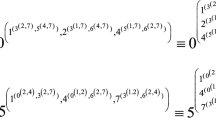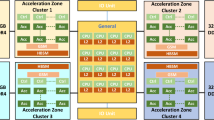Abstract
A methodology for the hierarchical partitioning and mapping of digital signal processing (DSP) tasks to heterogeneous local cluster based network of very large scale integration (VLSI) processors is presented. The goal is to achieve rapid prototyping of VLSI DSP systems. The high level partitioning issues of DSP task graphs and the proposed metrics to guide the partitioning process are described in this paper. Partitioning tominimize power inefficiency in the DSP system is one important metric addressed by this work, since low power signal processing is paramount to new portable and high density multi-chip module (MCM) DSP systems. The application of theRatio Cut Partitioning approach to DSP graphs is explained. We illustrate our results with examples and show how the final partitions vary depending upon the target architecture to meet rapid prototyping requirements. We compare our approach with known techniques and show that it works much better for our target applications.
Similar content being viewed by others
References
P. Wei, “Personal Communications on Studies in Next Generation VLSI DSP System Architecture,” University of California, San Diego, La Jolla, CA, May 1993.
T. Hamada, S. Banerjee, P.M. Chau, and R.D. Fellman, “Macro Pipelining Based Heterogeneous Multiprocessor Scheduling,”Proceedings of International Conference on Acoustics, Speech and Signal Processing, Vol. V, pp. 597–600, March 1992.
M.R. Garey and D.S. Johnson,Computers and Intractability: A Guide to the Theory of NP-Completeness, San Francisco, CA: W.H. Freeman, 1979.
C.C. Yu, L.J. Wu, and Y.S. Wu, “Constant Capacity, Fundamentals of DSP Architecture,”Proceedings of International Symposium on Computer Architecture and Digital Signal Processing, October 1989.
R. Broderson, A. Chandrakasan, and S. Sheng, “Low-Power Signal Processing Systems,”Proceedings of Application Specific Array Processors Conference, August 1992.
D.M. Brewer and L.P. Burnette, “MCM Designs Require Exhaustive Thermal Analysis,”EDN Magazine, pp. 96–104, December 1992.
S.R. Powell and P.M. Chau, “Estimating Power Dissipation of VLSI Signal Processing Chips: The PFA Technique,”VLSI Signal Processing, IV, pp. 250–259, November 1990.
L.R. Ford and D.R. Fulkerson, “Maximal Flow Through a Network,”Canadian J. Math, Vol. 8, pp. 399–404, 1956.
B.W. Kernighan and S. Lin, “An Efficient Heuristic Procedure for Partitioning Graphs,”Bell System Technical Journal, Vol. 49, pp. 291–307, 1970.
CM. Fiduccia and R.M. Mattheyses, “A Linear Time Heuristic for Improving Network Partitions,”Proceedings of 19th Design Automation Conference, pp. 175–181, 1982.
B. Krishnamurthy, “An Improved Min-Cut Algorithm for Partitioning VLSI Networks,”IEEE Transactions on Computers, Vol. C-33, pp. 438–446, 1984.
L.A. Sanchis, “Multiple-Way Network Partitioning,”IEEE Transactions on Computers, Vol. 38, pp. 62–81, 1989.
S.H. Bokhari, “Partitioning Problems in Parallel, Pipelined, and Distributed Computing,”IEEE Transactions on Computers, Vol. 37, pp. 48–57, 1988.
J. Opsommer, “A Taskgraph Clustering Algorithm Based on an Attraction Metric Between Tasks,”Proceedings of CompEuro-92, pp. 77–82, March 1992.
D.S. Johnson, C.R. Aragon, L.A. McGeoch, and C. Schevon, “Optimization by Simulated Annealing: An Experimental Evaluation; Part I, Graph Partitioning,”Operation Research, Vol. 37, 1989.
Y.C. Wei and C.K. Cheng, “Towards Efficient Hierarchical Designs by Ratio Cut Partitioning,”Proceedings of Interantional Conference on Computer Aided Design, pp. 298–301, November 1989.
V. Sarkar,Partitioning and Scheduling Parallel Programs for Multiprocessors, Cambridge, MA: MIT Press, 1989.
University of California, Berkeley: Electronic Research Laboratory,Almagest: Manual for Ptolemy Version 0.2.
K. Konstantinides, R.T. Kaneshiro, and J.R. Tani, “Task Allocation and Scheduling Models for Multiprocessor Digital Signal Processing,”IEEE Transactions on Acoustics, Speech and Signal Processing, Vol. 38, pp. 2151–2161, 1990.
Author information
Authors and Affiliations
Rights and permissions
About this article
Cite this article
Banerjee, S., Chau, P.M. & Fellman, R.D. Rapid prototyping methodology for multiprocessor implementation of digital signal processing systems. Journal of VLSI Signal Processing 11, 21–34 (1995). https://doi.org/10.1007/BF02106821
Received:
Revised:
Published:
Issue Date:
DOI: https://doi.org/10.1007/BF02106821




